In the 15th century, Pierre de Luxembourg laid out the boundaries of a park in the forest surrounding his castle in Enghien (Anguien), a small medieval fortress town near Brussels in Belgium. By the time the estate had been acquired by the aristocratic Arenberg (Aremberg) family at the beginning of the 17th century, the park boasted jousting fields, a menagerie, game reserves, flower gardens and irrigation systems.
The famed Renaissance-Baroque garden configuration at Enghien, depicted in the prints below, evolved during the 1620s to 1650s, guided by the elaborate landscape and architectural design choices of Le Père Charles de Bruxelles (Arenberg family member and architect). They were an amalgam of French and Italian influences. Elements were grouped around a central axis (French feature). They included formal parterres adorned with classical statuary, tree-lined avenues, an orangery, a large viewing mound (an Italian feature), a grand pavilion on an island surrounded by imitation bastions, an ornate sculptured fountain in the middle of a reservoir, a small terraced garden on an artificial island (another Italian feature), and a series of more traditional gardens surrounded by hedged tunnels.
Although technically outside of the Dutch Republic, Enghien gardens conformed to the Dutch garden aesthetic. And it was close enough to the border with Flemish Brabant that it could be easily reached by Dutch visitors who found it to be an exemplary and accessible Baroque garden model, whereas the gardens of Italy and France were not. For these reasons, the monumental Dutch topographical review from the mid-1700s by Christoffel Beudeker conspicuously included the Belgian Enghien gardens.
"They made plentiful use of water, by way of ponds, canals and moats. Using hedges, often cut into spectacular shapes, they created a series of outdoor green "rooms" or "cabinets", palaces, theatres and stage sets. Unlike the prevailing, unadorned green of Italian formal gardens, the Dutch created beds or parterres filled with the vivid colours and the beautiful scents of flowers, sometimes supplemented with coloured stones. Unlike their French counterparts, Dutch gardens fitted into their landscapes and did not dominate them.
The design of the gardens embraced sophisticated intellectual allegories deriving from classical legends and philosophy and they were created in accordance with the rules of architecture and logic. As well as pleasing the eyes, the gardens were also intended to appeal to the mind, their designs symbolising the earthly paradise and being intended to impart moral and philosophical lessons to the select few who understood them. Political often co-existed with philosophical symbolism, and many Dutch gardens were platforms for political propaganda that was all the more effective for being relatively subtle."
[BL: Dutch Baroque Gardens - Intro.]
The estate suffered from neglect and fires over the centuries and there were various attempts by successive owners to rebuild the chateau(s), rejuvenate the gardens and generally transform the property according to whim.
The estate became the property of the municipality of Enghien in the mid-1980s and major public works have seen faithful restoration of a Renaissance garden and a couple of pavilions, with overgrown woodlands felled and replanted and medicinal and flower gardens added in recent years. The efforts are ongoing.
The etched engravings below were produced in about 1680, commissioned from Romeyn de Hooghe by the Amsterdam map dealer and publisher, Nicolaes Visscher II.
View Larger Map

General design plan for the gardens at Enghien near Hainault in Belgium.
The Enghien park plan identifies the main features of the garden and shows how they fitted into the wider landscape. The Duke's palace (Chateau) looks out over the park at the bottom, with the old walled town (ville) to its right and the suburbs (fauxbourg) and cemetery on the other side.
The plan shows that the gardens were still under construction in the mid-1680s. While the main features and the formal gardens closest to the palace seem to be in their final form, Mount Parnassus (14), the fountain and colosseum (30) and the planned gardens in front of it (31) are noted as being unfinished (imparfait). Most of the estate within the old walls of the original hunting park (15) is still occupied by meadows and rough hunting land.


Note from BM in reference to the B&W image:
"Bird's-eye view of the renaissance gardens at Enghien near Hainault, with a pavilion surrounded by concentric plantings in a pentagonal design at centre, parterres and fountains in foreground, a large pond at right; title in banderol at top centre with putti and coat of arms; lettered a-z and numbered 1-17 within composition indicating locations; unsigned. 1680
Engraving with etching."
{The BL suggests this B&W version of the engraving was done twenty years later, in 1700, by a different artist elaborating on de Hooghe's original: see here. If nothing else, this reinforces the notion that de Hooghe had perhaps recorded an 'intended' design rather than a completed garden layout}

As well as giving a more realistic idea of the actual size of the park than is conveyed by the bird's-eye views, this pavilion view is able to convey an idea of the sort of people who likely visited the park. Almost without exception they seem to be prosperous burghers and aristocrats.
Fourteen lanes and avenues (the so-called allées) radiate out from this central pavilion, each bearing a unique character according to the specific landscape design and plant species in use.
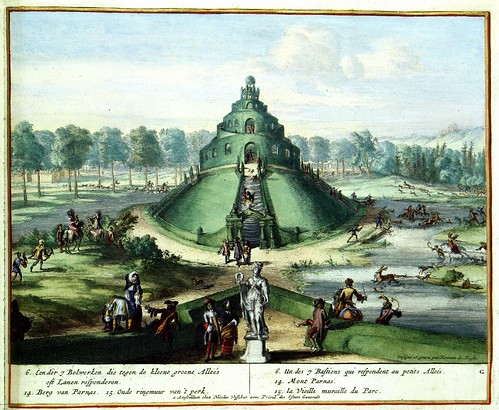
Parks often contained a model Greek Mountain of Parnassus [see Catshuis for example]. In antiquity, the Parnassus, dedicated to Apollo and the Muses, was the traditional home of poetry and music. Deer are being hunted at the foot of the 'mountain' and some boys are climbing over the low walls of the bastion to join in.
![Aangezicht op de] Orangien Hoff met de marmere fonteyn van de drie gratien](http://farm5.static.flickr.com/4107/5064993708_46b1510f32.jpg)
An orangery (citrus orchard) first began to appear as an element of landscape design in the Renaissance gardens of Italy. Orangeries became a staple of the Dutch baroque gardens (often built in glass-enclosed hot-houses or warmed with fires to protect against the harshness of Northern European winters) and were associated with the legendary gardens of the Hesperides*, where Hercules received the golden apples as reward for his virtues. It is no coincidence that a statue of Hercules can be seen in the far background of this print.
[and/or..]
The scene juxtaposes a foliage niche enclosing a statue of the Greek hero Hercules with a fountain showing the Three Graces. Like Hercules, the Graces were the illegitimate children of Zeus, the King of the Gods. While Hercules epitomised strength, the Graces, Euphrosyne, Aglaea and Thalia, were the embodiment of beauty, grace and wisdom. Whether these associations meant much to the garden's visitors is another matter. It is a hot day and a family is shown enjoying the shade. A beggar woman sits in the full sun while a group of friars to the right debate whether or not to give her any alms.
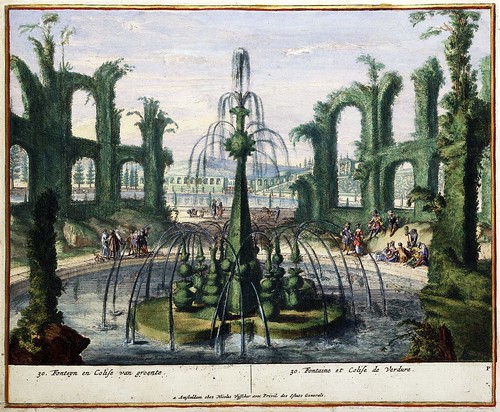
One of the fountains seen against a background of green hedges. The "colosseum" is clearly modelled on the one in Rome.
![Uitzicht op het] Groot rond met de bouteveue op den berg](http://farm5.static.flickr.com/4108/5064995150_ef3b455ba8.jpg)
The print records the view across the large reservoir, with the kitchen garden and pavilion of Samson to the left and the herb garden to the right. Enghien houses can just be seen over the town wall to the right; straight ahead are the garden gates and beyond it a hill and a well-placed tree to round off the view. The Vicereine of the Southern Netherlands is on the point of leaving the gardens and to the left, a young man gives a farewell salute on a hunting horn.
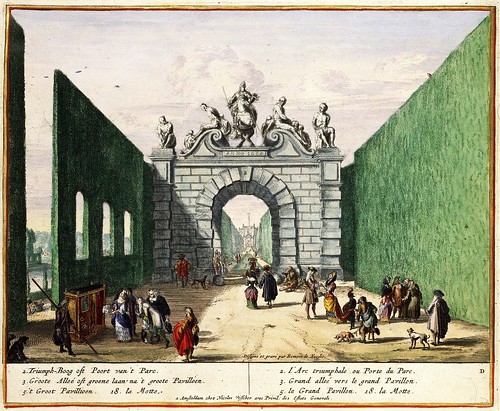
The print shows the main entrance to the park, a triumphal arch (the Slave Gate or La Porte de l'Esclave *I think*). Visitors entered here into the groote allee oft groene laan, the lane that led to the main pavilion in the centre of the park. To the left can be glimpsed the large basin or pond with the island garden on a mound.
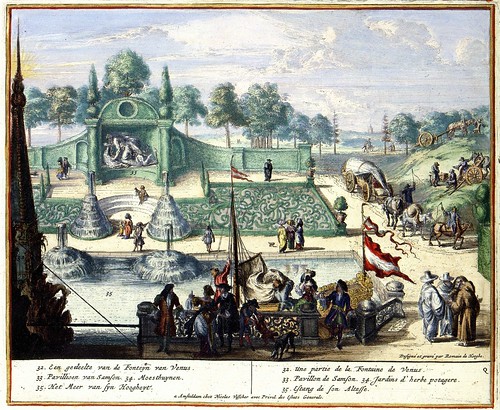
The orchard and vegetable and spice gardens formed an integral part of Enghien park estate. These plots, separated by high green hedges, were built on both sides of the entrance ways to the park.
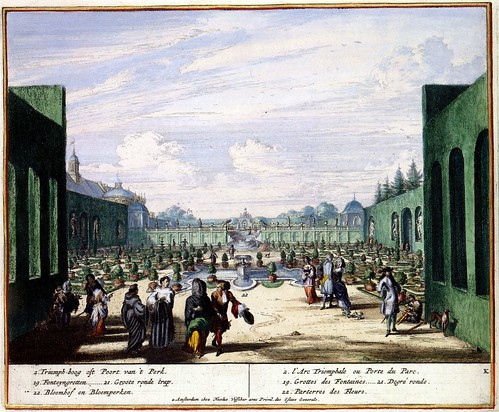
The print shows the bloemhof (flower garden) with an extensive variety of plants and flowers (not in-bloom). During the second half of the 17th century such flowerbeds were very popular. Beyond simply presenting a large variety of colours and fragrances, gardeners and their employers were obsessed with collecting exotic flower specimens from all over the world. The diversity of the Enghien park collection contributed greatly to its reputation as one of the finest gardens in Europe. The garden front of the Duke of Aremberg's palace looms beyond the hedges on the left. The blue-roofed pavilions in the middle distance are grottos which housed small fountains. The hedges along the sides have been clipped to provide niches for the statues that are well integrated into the overall design. Gardeners at work, friars and beggars add interest to the scene.

With this grotto fountain, the garden architect tried to invoke an imaginary world of stones, shells and water. This was an attempt at imitating nature and is linked with classical ideas about the natural world, art and, above all, love.

View of the grand pavilion from one of the maple-lined allées leading to it. A carriage drawn by six (?)white horses and accompanied by three footmen drives down the centre of the avenue: it is probably occupied by the Marquesa de Castagna, the wife of the King of Spain's viceroy in the Southern Netherlands (Vicerine, one presumes). Meanwhile, a gardener wheels a wheelbarrow into the avenue and a child plays. A steep wooden staircase enabled visitors to reach the viewing gallery at the top of the grand pavilion.

Visitors are seen navigating their way through the popular maze or labyrinth (which was created at the same time as the surviving maze at Hampton Court) while onlookers enjoy a flagon of wine. A large statue of Amphitrite, Poseidon's wife and goddess of the seas in Greek mythology, is placed at the centre of the maze. Taken together with Mount Parnassus and the numerous other statues of Greek gods and goddesses that adorned the park, this statue seems to underline the message that the gardens of Enghien were indeed a heavenly place and a terrestrial equivalent of the pantheon of the Greek gods.
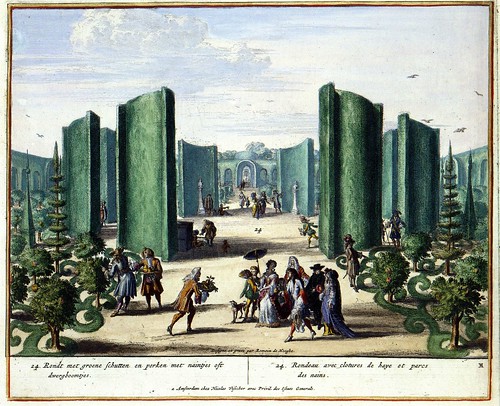
Pride of place in this scene goes to the hedges that have been clipped to form screens, foliage tunnels and an obelisk. The mature orange trees in the foreground are laden with fruit which is being picked: a surprising harvest in a location as far north as Enghien. The aristocratic lady in the foreground is about to be presented with fruit.
![Aangezicht op het pavilioen van Samson en het meer van] sijn Hoogheyt](http://farm5.static.flickr.com/4150/5065003698_5cf161c51e.jpg)
De Hooghe has drawn his visitors at the crossroads of two lanes. The view on the left leads through an avenue and across a large reservoir and the extensive kitchen gardens to the pavilion of Samson in the background. To the right the view extends northwards through almost the full extent of the park to another fountain. The avenue leading to this is called the "Maille" or Mall. Like the London streets of the same name it takes its name from the game pell mell, a form of croquet which was very fashionable at the time and which two gentlemen are shown playing. Behind them others are practising fencing.

The view from the grand entrance to the Italian-style island garden. Visitors are stepping onto the island from a small boat. On the right a man pulls on a rope hauling another boat, that cannot be seen, across the water. Deer graze in the enclosure between the water and the old park wall in the distance.
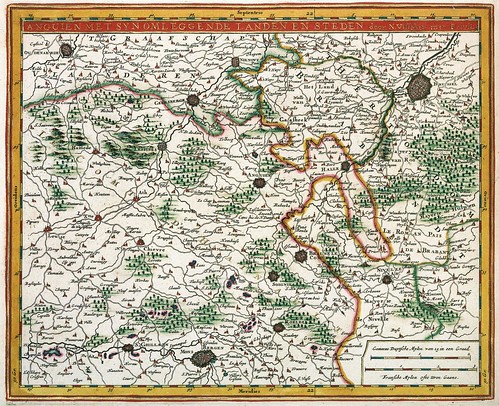
The map was meant to guide visitors of the famous pleasure gardens of Enghien located south of Brussels, the proud property of the princes of Arenberg.
Romeyn de Hooghe (1645-1708) was an energetic Dutch etcher/engraver, painter, sculptor, author, goldsmith, art dealer and teacher, who was active in Amsterdam and, later, Haarlem.
Operating at a time when the production of graphic work and books from Dutch publishers was at its pinnacle of volume and variety, de Hooghe produced single-leaf prints, broadsheets, pamphlets, sea charts and maps, and book illustrations, etching well over four thousand plates in all.
De Hooghe was industrious, tireless, inventive and his work covered the gamut, from political satires and portraits, to allegorical fantasy, landscapes and even pornographic prints. He is often described as the most or one of the most important Dutch artists of the late 17th century, a comment that may say as much about his prolific work ethic as it does about his place in the pantheon of art.
"His line-work is never less than immensely skillful and meticulous; still, the impression is often predominantly one of workaday laboriousness. His oft-repeated trick of juxtaposing dark, shadowy foregrounds against light middle-to-backgrounds is dramatic but sometimes over-mannered." [source]
"Above all, Romeyn de Hooghe was a master in illustrating contemporary events, such as the 'Disaster Year' of 1672, the coronation of the Dutch Stadholder William III as King of England in the Glorious Revolution of 1688, and the wars of the Habsburg Emperors against the Ottoman Turks in Eastern Europe. His was a tumultuous time both politically and socially, but it has not received as much attention as the earlier years of the Dutch Golden Age. The great masters – Frans Hals, Rembrandt, Vermeer – had already passed away by the time Romeyn de Hooghe became the representative of the later Golden Age. Luckily, we have his works to help us get a picture of that time." [source]
- The images in this post - except where noted - were sourced from a search at the Memory of the Netherlands site. The 'original' large images uploaded to flickr are about half the size as those available at the source site.
- The Atlas Van der Hagen and Atlas Beudeker site at the Memory of Netherlands.
- 'The Oxford Companion to the Garden' 2006 By Patrick Taylor.
- Dutch Baroque Gardens at the British Library (access to Turn the Pages format).
- Historic Gardens of Europe (English summary items, links to external garden websites - including Enghien en Français).
- Enghien at Wikipedia.
- Parc d'Enghien Flickr pool.
- Parc d'Enghien at Wikimedia.
- Romeyn de Hooghe exhibition site at Rijksmuseum (in Dutch) [searching the artist's name at Rijksmuseum is probably the best location to get a fair overview of his artistic legacy]
- OAC inventory of de Hooghe etchings includes biographical material.
- Previously: Catshuis (also published in Amsterdam by Visscher) on Jacob Cats' estate.



















11 comments :
wow! amazing gardens... fascinating post, thanks!
oh, how I wish I could go back in time to see this! Thank you so much for this post !
It's still impressive - though I wish they had not destroyed the pentangle - that was a cool touch! Thanks for posting this.
Thanks so much for posting these, I hadn't seen these garden images before, will add to the collection.
I often wonder exactly how 'neat' those hedge walls actually looked. In the prints they seem so perfect and almost too thin, I wonder how much is real and how much is artistic license.
Good point, Katya. I was just about to say how utterly surreal each of the images seems, which while being absolutely compelling also has to make you wonder how accurate they are.
Either way, I could stare at these all day.
Thanks for this. Worth noting that this style of engraving was championed (in the UK at least) by Inigo Jones during the 1600s. Trained in the theatre and responsible in designing sets for the monarchy's elaborate 'masques', or theatrical spectacles, the influence of set design is obvious in his architectural work.
I would say that I see the same trend at work here, especially in the use of flat, 'scene'-like planes in some, and amphitheatrically-shaped negative space in others. They vary greatly from, say, someone like Piranesi, whose capricciosi are almost 'ob-scene', that is to say, abstractly cropped and using a variety of depths of field.
LOVE enghien castle... my second cousins once removed or some shit live near there... LOVE belgium in general. and brussels, I know its not cool but I do!
This is so wonderful! You did a great job of laying out the illustrations and background information with all of this. Thanks, I really like this garden looks like such a fairy tale fun and exciting world to me!
Wonderful post, as always! Your informative commentary is especially appreciated.
Thank you for your scholarship and presentation Peacay. I'm so glad that Thombeau's post brought me to your blog.
Thanks everyone. Sorry for my apparent absence; which, more properly, should be read as: lazy observer. I like to watch.
Just revisiting this post I'm reminded that the image quality is fairly mediocre, as though the prints were lifted from acetate or plastic film. They're adequate, of course, in terms of design features and layout, but the quality of the digital files (as opposed to the original prints, I'm sure) is disappointing. Ah well, beggars like me oughtn't complain too much.
Post a Comment
Comments are all moderated so don't waste your time spamming: they will never show up.
If you include ANY links that aren't pertinent to the blog post or discussion they will be deleted and a rash will break out in your underwear.
Also: please play the ball and not the person.
Note: only a member of this blog may post a comment.